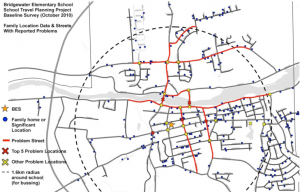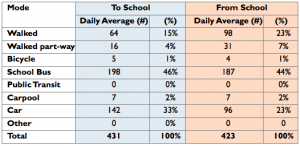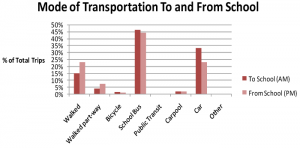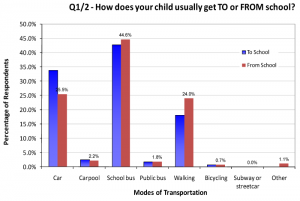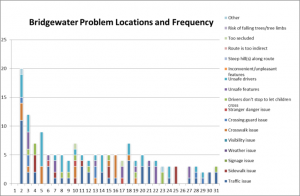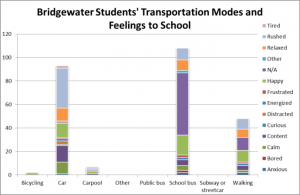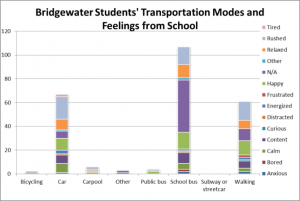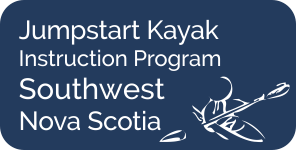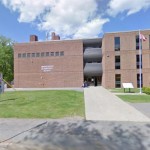 March 2012
March 2012
Compiled by Jennifer McGowan
School Travel Plan Facilitator, Ecology Action Centre
902.442.5055
We thank our Nova Scotia partners: Province of Nova Scotia, Transport Canada, Halifax Regional Municipality, Cape Breton Regional Municipality, Municipality of the District of Chester, Town of Bridgewater, Municipality of the County of Annapolis, Halifax Regional School Board, South Shore Regional School Board, Cape Breton-Victoria Regional School Board, Annapolis Valley Regional School Board, Halifax Community Health Board and Southeastern Community Health Board. Production of this material has been made possible through a financial contribution from Health Canada, through the Canadian Partnership Against Cancer; and from the Public Health Agency of Canada. The views expressed herein represent the views of Ecology Action Centre and do not necessarily represent the views of the project funders.
![]()

![]()

1. Introduction
School Travel Planning (STP) is a community-based approach that aims to increase the number of children choosing active transportation modes to get to and from school. An increase in the number of students walking, cycling, taking transit and carpooling to school helps to address important issues of sustainability, safety and health associated with the school run.
Key community stakeholders work together to identify, and solve their school transportation problems. These stakeholders include school boards, municipalities, police, public health professionals, parents, educators and students.
School Travel Planning involves five steps:
1) Program Set-up
a) The STP Facilitator establishes a Municipal STP Steering Committee comprised of all relevant stakeholders (school board, parents, police, traffic engineers, local politicians, public health department, etc.) to provide expertise and guidance to all schools engaged in the project in their municipality;
b) The STP Facilitator selects schools to participate, ensuring they are committed; and
c) Each participating school, with support from the STP Facilitator, establishes a School STP Committee comprised of teacher(s), parents/caregivers and other interested parties to manage the STP process at the school level beginning with determining goals.
2) Data Collection & Problem Identification
Survey parents/caregivers and students, map neighbourhoods where students live, identify best routes, conduct traffic counts.
3) Action Planning
STP Committee designs a plan of action for dealing with challenges identified and achieving stated goals. At this stage a written document is compiled that summarizes background information and outlines the detailed action plan that includes initiatives, timelines and assignment of responsibility for each task.
4) Implementation
Action items are carried out.
5) Ongoing Monitoring
Post-implementation data collection is done to evaluate progress toward goals. The plan is tweaked if necessary. A School Travel Plan is intended to be a living document that becomes part of school policy and is revisited and updated on a regular basis.
2. School Overview
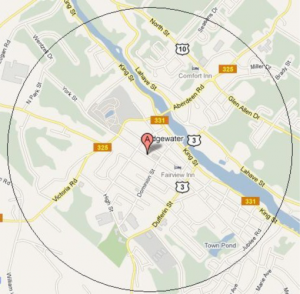
Map of the 1.6km zone around BES; South Shore Regional School Board (SSRSB) transportation policy states that 1.6km is the walking distance for younger elementary students (click to enlarge)
The Town of Bridgewater, Nova Scotia is a thriving town nestled in the heart of the LaHave River Valley. It is considered the “Main Street of the South Shore”, and offers numerous amenities including restaurants, accommodations, a traditional main street as well as a mall, a regional hospital, banks, museums, parks and recreational facilities. Bridgewater Elementary school (BES) is situated adjacent to Bridgewater’s town centre in one of the town’s oldest neighbourhoods. The neighbourhood is characterized by a compact street grid and modest lots that primarily host pre-1920 homes, and a relatively high residential density. The majority of homes in this area are single-family dwellings, though a diversity of other housing types are also present. These features, combined with well-maintained streets, sidewalks and mature trees give the area a well-connected and walkable residential character.
As a public school, BES serves approximately 510 students (or 366 families) from grades primary to six. Roughly 45% of BES’s students are bused to school on a daily basis, while the remaining 55% of the student body walks, cycles, or is driven to school (further transportation modal breakdowns are described in section 4). Once students graduate from BES they move on to the Bridgewater Junior Senior High School, which is located next door. There are green spaces as well as a few parks and recreation facilities (including a hockey rink) nearby.
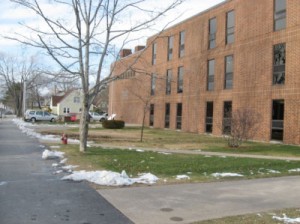
BES facing York Street
The school has no parking lot. There is a designated wheelchair drop zone on the street in front of the school. Bike racks with space for 16 bicycles are located on the school grounds.
Playground supervision begins at 8:30 a.m. The entry bell rings at 8:48 a.m. Recess falls between 10:50 and 11:05 and lunch is from 11:55 to 1:00 p.m. Dismissal for grades P – 2 is at 2:35 p.m., and grades 3 – 6 end their day at 2:35 p.m. (walkers) and 2:38 p.m. (bus students). The school also offers a breakfast program from 8:30 a.m. to 8:45 a.m.
This school has an excellent playground area that is well used by the community. Parent support at the school is strong, and the school takes part in many fundraisers and extra-curricular events.
The school’s community response police officer visits the school regularly and has a good rapport with the students. The officer participates in many school initiatives and is supportive of the School Travel Planning process.
The community makes good use of the school after hours, using it as a gathering space. The gym is often booked for sports and the library and classrooms are regularly used for club and committee meetings.
3. Travel Challenges Summary
The school itself is surrounded by fairly busy streets, especially in the morning and afternoon when children are arriving at and leaving the school grounds. The top most cited issues by parents in the family survey were “traffic issues” and “unsafe drivers”. Parent comments included concerns over speeding, traffic volume, and drivers not paying enough attention to pedestrians and cyclists. In the baseline data analysis phase, seven problem streets were identified and over 32 problem locations. This map below is a summary of the top cited problem streets and locations. For a more detailed account of the issues raised in the family survey please see the “BES STP (Baseline) Data Collection Phase Results-November 2010” report.
The next most cited problem at BES, “crosswalk issues”, is related to the first issue (and many parents discussed both unsafe drivers and crosswalk issues in their comments).
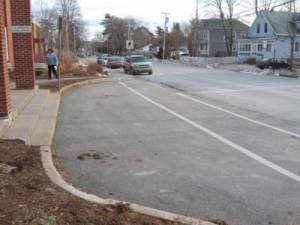
Unsafe crosswalk in front of Bridgewater Junior Senior High School
Crosswalks were cited as missing at key intersections or crossing points (examples include, Haven Dr./Seasons Dr. and North St., Dufferin St. and Churchill St., Churchill St. and Dominion St., Empire St. and Pleasant St., Victoria Rd. and Pleasant St., Prince St. and Maple St., Alexandra Ave. and Maple St., Hollingworth Dr. and Ridgecrest Dr., High St. and Empire St. and the often mentioned Nafthal Dr. and Glen Allen Dr.) and parents stated that drivers often failed to yield to pedestrians at crosswalks (even crosswalks with crossing guards). Parents felt there should be four-way stops at the corners of Queen St. and Empire St. and Queen St. and Dominion St. They also felt there should be more crossing guards at intersections around the school, including at Dufferin St. and York St., Queen St. and Dominion St. and Queen St. and Empire St. Parents also noted that the drivers do not always respect the crossing guard at Empire St. and York St.
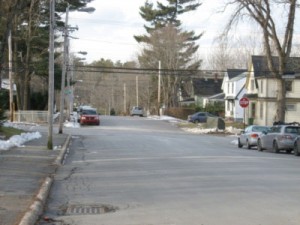
Corner of Queen St. and Empire St. There are no sidewalks on one side of Queen Street. The school is to the left of where this picture was taken.
During the walkabout, and from the parent surveys, the crosswalk in front of Bridgewater Junior Senior High School was identified as an unsafe crosswalk. Cars try to use the space as a drop zone, but no more than two can fit at one time and often the crosswalk is blocked by a car. Cars have to drive over the crosswalk to enter the space, creating a high potential for car and pedestrian conflict. The crosswalk across the road also intersects the space. Many children from BES walk past this spot every day.
The final most cited issue at this school was “sidewalk issues”. A number of streets on routes to school only have sidewalks on one side of the street, and certain residential streets lack sidewalks altogether. Sidewalk maintenance and snow clearing issues were among the cited concerns as well.
4. Travel Survey Baseline Data
Travel data was collected through a variety of strategies, including: site visits; walkabouts with both community stakeholders and committee members; classroom surveys of students; take-home surveys of families; and traffic counts.
Classroom “Hands Up” Survey
To collect information on how students get to and from school, a classroom “hands up” survey was completed in all 20 classes during the week of September 27th – October 1st, 2010. There was a high level of consistency of results between all five week days and between 418-434 students took part each day. The results of this survey are shown in Table 1 and Figure 1.
More detailed information on the travel habits to and from school of families at BES was gathered via a family “take home” survey, which was administered the week after the classroom surveys. Families were given until October 8th, 2010 to complete them and return them to the school.
The response rate was (281 / 354) 79.4%. Figure 2 summarizes the results of the family survey for travel to and from school. Comparing these results to the responses garnered from the classroom surveys (Figure 1, above) shows some differences, but a very similar modal share.
Some notable findings of the family survey include:
- More than one third of students (33.9%) are driven to school and 25.5% are driven home
- Less than one quarter of students walk to school and from school.
-
Approximately 43% of families who responded to the survey live within 1.5 km of the school
- Less than 10% (9.9%) of parents/caregivers were driven to school as children, 43.2% walked and a similar percentage to their children’s current mode took the school bus (45.8%)
- The top three reasons why students are driven to school are: time constraints make driving convenient (21.7%), school is en route to another destination (21.4%), and because the distance from home is too far (15.9%)
- More than a quarter (27.6%) of parents/caregivers who responded to the survey would allow their children to walk to school if they were older
- 24.6% of parents would allow their children to walk if they were not alone (when combined with those who would allow older children to walk that equals 52.2% of parents)
- 66.2% of parents/caregivers do not think there are significant barriers to walking in their local neighbourhood
For a more detailed analysis of the Family “Take Home” Survey please see the “BES STP (Baseline) Data Collection Phase Results-November 2010” report.
Codes for Locations of Concern
2. Dominion & Queen
3. Dominion St. (General)
4. Victoria & York
5. New Bridge
6. Bridges (General)
7. LaHave & Old Bridge
8. King & Old Bridge
9. LaHave St. (General)
10. Aberdeen Rd. (General)
11. King St. (General)
13. York & Dominion
14. North St. (General)
15. Glen Allan & Nafthal
16. Duck Pond on Alexandra
17. Aberdeen & North/Glen
18. Alexandra & Maple
19. King & New Bridge
20. LaHave & New Bridge
21. Old Bridge
22. Dufferin St. (General)
24. Miller Dr. (General)
25. Blank
26. Pine & King
27. King & Dominion
28. York & Empire
29. Dufferin & Hillcrest/Walnut
30. Brooke & Jubilee
31. Churchill & Dominion
32. North & Haven/Seasons
33. Other
School Site Visit and Walkabout
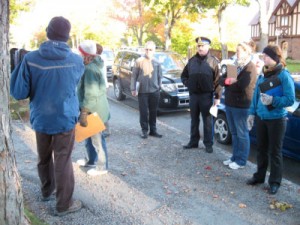
One walkabout group discusses the amount of gravel on the sidewalk along Queen Street
On the morning of October 18th, 2010, the BES STP Committee met at 8am at the Queen St. entrance of BES to witness the school’s travel challenges first hand. Some key issues that were noted include:
- Condition of pavement and maintenance of paved surfaces.
- Potential for vehicle-pedestrian conflicts in areas where parents currently drop children off.
- Number/location of, and security/shelter provided by bicycle parking facilities.
- Parking and driving behavior of parents.
- Crosswalks located near driveways and loading zones.
We decided to split into two groups, one walking around the school clockwise, the other counter clockwise. Due to the large size of the block and the amount of points of interest around the school each group only concentrated on the immediate block around the school (Queen St., Dominion St., York St. and Empire St.).
Upon returning to the school, we met to discuss potential action plan items for Bridgewater Elementary’s School Travel Plan from 9 a.m. to 10:30 a.m.
Issues discussed include:
|
Category |
Comments |
| Needs Improvement – SCHOOL GROUNDS | |
| school entrances — convenience, safety, accessibility |
|
| pavement maintenance (cracks, snow and ice removal, mud, puddles need filling, etc.) |
|
| bike parking — number, security, and shelter |
|
| school buses — location of loading zone |
|
| school buses — supervision at loading zone |
|
| location of garbage dumpsters and other school maintenance equipment |
|
| Needs Improvement – NEARBY STREETS | |
| parking and loading areas — potential for vehicle and pedestrian conflict |
|
| cars blocking pedestrian routes |
|
| are there sidewalks? how far do they extend around the school and into the surrounding community? |
|
| physical state of the sidewalks |
|
| curb cuts and other accessibility features |
|
| pedestrian crossing devices present and utilized |
|
| number and position of crossing guards / other safety personnel |
|
| placement of crosswalks in relation to driveways and bus loading zones |
|
| something else |
|
| location of problems |
|
| Needs Improvement – OTHER ISSUES IN THE NEIGHBOURHOOD | |
| location of other public spaces near school: parks, community centres, libraries, churches |
|
| number of shade trees on streets |
|
| green space vs. concrete space |
|
| Block Parent or Neighbourhood Watch community — are Block Parents located nearby? |
|
| potential or known areas where bullying, loitering, or intimidation is possible |
|
Photos from the first Walkabout:
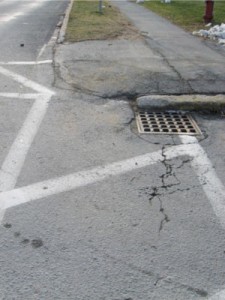
Corner of Queen St. and Dominion St. Curb cut is workable but not ideal.
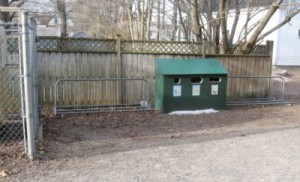
Bike racks were hidden along the side of the school, behind the garbage bins and oil storage. They were not visible nor in a safe location.
After the first walkabout, two more walkabouts were conducted at the top problem locations identified through the parent surveys on routes to school to learn more about the conditions there. These walkabouts took place on May 31st and June 22nd, 2011.
Leon de Vreede, Bridgewater’s Sustainability Planner, completed detailed descriptions of those walkabouts, problem areas discussed and solutions proposed. Please contact Leon de Vreede for more information on the results of these walkabouts. The Town of Bridgewater is actively considering making improvements to some of the locations identified.
5. Objectives

Sustainability Planner Leon de Vreede holds up the BES Walking School Bus safety vests for adult/older youth leaders and patches for students backpacks.
The committee feels there is great potential for more children to walk and bike to school and therefore chose this goal as their first objective. Of the BES families surveyed, 42.7% live within 1.5km of the school (less than the recommended walking distance of 1.6km for younger elementary grades) and 90.3% live within 3km of the school (biking distance). Even with most families living within walking or biking distance, according to the hands up classroom survey, only 15% of students walk (1% bike) in the morning and 23% walk (1% bike) in the afternoon. Instead of walking or biking, 33% are driven in the morning and 23% in the afternoon. The committee feels there is potential to shift some families from driving to walking or biking. Various programs, such as Walking School Buses, and celebrating various walk to school days (IWALK and Winter Walk Day) are ways the committee hopes to achieve this objective.
The committee’s second objective is to create clear and safe accessible routes to school. Part of this is through mapping as well as improving infrastructure both on school property and off, connecting this school work to the ongoing Bridgewater AT Committee’s work.
The school STP committee also aims to make the community more aware of active transportation and school travel planning. This will be done through the school newsletter, various presentations, and making connections with local media.
The committee aims to build more skills in active transportation, through programs such as Making Tracks (active transportation safety and skills training for children and youth). And finally, the committee plans to continually monitor the effectiveness of all these initiatives and revise this School Travel Plan annually to ensure there is an ongoing record of this work at the school.
6. Action Plan
Bridgewater Elementary STP Committee Purpose Statement:
To create a supportive environment for active travel and make active forms of travel a more attractive option for the families of Bridgewater Elementary. This project is in partnership with the Town of Bridgewater’s Active Transportation Committee, the Ecology Action Centre as part of Active and Safe Routes to School and the School Travel Planning Project, and many other groups, organizations and committees in the school community.
Potential Motto Brainstorm:
Just Go, One Step at a Time, On the Move, Take the Initiative and Walk Your Kid to School, Step it UP, Moving Forward…
Objective 1: To encourage more students to walk or cycle to and from school
Estimated Monetary Cost & Source of Funds Status
Action/Initiative: Walking/Cycling School Bus program
Tasks: -W/CSB Planning Party to identify families who want to participate
-safe route planning and W/CSB policies for BES
-promotion (invite Stacey Colwell to planning party or before)
Responsibility: Mike and WSB subcommittee
Timeframe: April 2011 and ongoing
June 15, 2011 WSB Planning Party ? food at party?/props/safety vest/signage?
Done and Ongoing – Three routes currently running (started Fall 2011) with plans to recruit high school students and more parents to expand
BES Bike Week -could do at similar time to HRM Bike Week (May 27-June 5) Terry? May/June 2011 ? Delayed until spring 2012
Bike and/or Walking Club Start a bike and/or walking club, possibly as an afterschool program Terry Melloy ? ? Ongoing as part of Making Tracks program
WOW (“We Often Walk or Wheel”) Children keep track of everyday they walk with a WOW card. Once card is filled they could be entered into a prize draw, or classrooms could track distance walked and earn prizes. http://saferoutesns.ca/index.php/special/wow/
Teachers at BES? Mike Stewart? As part of WSB ? ? Ongoing– Idea for the future
Obtain School Board Approval for STP Have STP listed as a School Board Approved activity in the SSRSB Transportation Policy Marci Elliot, Siobhan Doyle and Jennifer McGowan March 8, 2011 none Done – presented on March 8, 2011 and approved on April 27, 2011
Objective 2: To create clear and safe accessible routes to school
Infrastructure
-on school property Bike racks (move old ones, add more bike parking), improve identified problem areas Mike Stewart, SSRSB? 2011 ? ?? Bike rack move Done (Fall 2010)
Infrastructure improvements on routes to school Identify problem locations on routes to school, and clarify the cause of each problem, starting with locations closest to the school
Determine appropriate solutions to problems (short term / long term)
Implement upgrades on an annual basis as resources allow
Install shared bicycle lane route along York St (2012) Town of Bridgewater, AT Committee (advisory), Leon de Vreede (liaison) 2011 – ongoing To be determined. Source: Town of Bridgewater annual budgets. Some funding may be available from Province and Federal Gov’t. Ongoing – The Town of Bridgewater has done a lot of work compiling and investigating issues found in the family surveys and through area walkabouts; please contact Leon de Vreede for more information
STP Committee Advocates for Infrastructure Changes -Create list
-write letter(s)
-presentation(s) BES STP Committee? Leon de Vreede? Who else? ? No direct cost? Ongoing – integrated as part of the Town of Bridgewater AT Committee
Objective 3: To make the community more aware of active transportation and school travel planning
Regular spot in monthly BES newsletter Write up small article on STP and active travel for the BES newsletter each month
E.g. profile families who walk (call out to parents), how long does it actually take to walk 1.6km, connections between physical activity and greater ability to learn/pay attention Lead: Siobhan
Help: Mike Stewart? Others? BES STP Committee? On going No cost Ongoing – events and milestones announced in newsletter, monthly larger article Delayed
Presentation to parents Give a presentation on STP at BES, data results, planned activities, etc. Jen McGowan (STP Facilitator) and Leon de Vreede (Sustainability Planner, Town of Bridgewater) Jan. 18 2011
(Completed) No cost Done (Jan 18, 2011)
Semi-regular article in Bridgewater Bulletin Connect with Stacey Colwell periodically with STP updates – invite Stacey to WSB Planning Party Mike Stewart? Leon de Vreede? Others? On going No cost Done (Nov 2010 and Sept 2011) and Ongoing
Presentation to SSRSB and ongoing regular updates Discuss importance and success of STP in general and specifically at BES Marci to set up date with Steve and Nancy at SSRSB March 8, 2011 and ongoing No cost Done (March 8, 2011) and Ongoing – plans to continue communication with the SSRSB
Objective 4: To build skills in active transportation
Skills and Safety Education (Making Tracks in partnership with community members, police, teachers?)
http://saferoutesns.ca/index.php/special/making-tracks/
Set up and run bicycle and pedestrian safety training courses (in gym class, after school, through the recreation department and already existing training opportunities) Jen McGowan (help facilitate Making Tracks training), Terry, community volunteers? Others? Winter/Spring 2011 Safety and skills education print materials for program and take home provided by Ecology Action Centre, others? Done (Terry Melloy phys ed teacher trained in April 2011 in Cycling and STP committee members trained in Walking on March 3 2012) and Ongoing (Terry has started offering parts of the program, is currently trying to secure bikes for the program, hopes to offer the full program this Spring, for walking program hope to incorporate into WOW)
Objective 5: To monitor effectiveness of initiatives and revise School Travel Plan annually
Conduct Baseline and Follow up Data Collection Year One and Year Two Classroom Hands-Up Surveys, Family Surveys, Traffic Counts and Walkabout BES STP Committee Fall 2010 (all tools)
Spring 2011 (Classroom and Family Follow Up Surveys) photocopying Done (Fall 2010 and Fall 2011)
STP document and action plan Creation of the STP ‘living’ document Jen McGowan (STP facilitator) and Leon de Vreede in partnership with the BES STP Committee Jan. 2011 and on going (first draft by Feb. 2012) No direct costs Ongoing
Monitor transportation modes in future years Conduct Classroom Hands-Up Survey Mike Stewart? BES STP Committee? Fall 2012? Spring 2012? On going? photocopying Possibility for future
Update STP report yearly Oversee the implementation of Action Plan items and track the actual timing and cost of initiatives versus planned
Update the action plan and STP report with additional actions, interventions, stories, data and events yearly BES STP Committee Ongoing No direct costs Ongoing
Highlights of actions to date for Bridgewater Elementary (June 2010-Jan 2012):
- Walk to Breakfast 2010 and 2011
- Three Walking School Bus routes started Sept. 2011
- Surveys completed Fall 2010 and Fall 2011
- Terry Melloy, phys ed teacher trained in Making Tracks Cycling and beginning of cycling education at BES
- Connection made with Bridgewater Jr./Sr. High (potential for High School WSB leaders)
- South Shore Regional School Board added support of STP in Transportation Policy, and the School Insurance Program due to this will cover volunteers involved in STP under school liability insurance
- Bike Rack moved to front of school, Fall 2010
- Three productive infrastructure walkabouts involving multiple stakeholders (including detailed reports of the walkabouts)
- Infrastructure requests from parent surveys included in the Town of Bridgewater AT infrastructure process through the Bridgewater AT Committee
- Great media coverage throughout process
Ideas for the Future:
Objective 1: To encourage more students to walk or cycle to and from school
| Drop & Go | Identify suitable locations for students to be dropped off outside the school zone to walk/cycle ine.g. Medical Arts Bldg? |
| Buddy Program | -Set up program to encourage students to walk and cycle with others (connect with W/CSB)-Contact high school to get older students involved (connect to volunteer points) |
| “No Car Days” | Based on Arthur Orsini’s program model where students and their families all picked at least one day a week to go “car free” to school, or beyond, that worked best for them. Buttons were made that said “No Car Monday”, “No Car Tuesday”, etc. or “No Car Everyday”. http://www.urbanthinkers.ca/ Tie to walk to breakfast |
| Heartland Tour | Takes place in July normally. Could promote to children before school ends in June. http://heartlandtour.ca/ |
| Health Program Grade P-6 | Connect with curriculum? |
Objective 2: To create clear and safe accessible routes to school
| Best Routes Map | Identify best routes to school, create map showing best routes, that includes crossing guard locations, cross walks, drop and go areas, and distribute to families along with pedestrian safety information, mark best routes with signsMake a part of WSB |
| Signage? | Install new safe route signs? |
| Safety Awareness Zoning | Paint markers and signage on the pavement that would designate certain zones school/pedestrian zones first |
Objective 3: To make the community more aware of active transportation and school travel planning
| Link STP and AT to curriculum at BES | Work with teachers to encourage them to talk about the importance of walking and biking in their classes, use walking and biking as an example in class discussions, and have visuals tracking progress and for recognition |
Objective 4: To build skills in active transportation
| Transition to School Program | Link to this program at the family resource centre Debbie SmithTrain in Making Tracks Walking in July? |
7. Consultation
The School Travel Plan is the result of joint efforts by multiple stakeholders:
Members of the School STP Committee
André Bouchard, Physical Activity Capacity Co-ordinator Department of Health and Wellness; Physical Activity, Sport and Recreation South Shore Regional Office andre.bouchard@gov.ns.ca
Cst. Will Creamer, Community Response Officer Bridgewater Police wcreamer@bridgewater.ca
Leon de Vreede, Sustainability Planner Town of Bridgewater ldevreede@bridgewater.ca
Siobhan Doyle, parent sio@eastlink.ca
Cheryl Fougere, parent fougeres@eastlink.ca
Jenn Kendrick, School Health Promoter (at arms length) South Shore District Health Authority/South Shore Regional School Board JKendrick@ssdha.nshealth.ca
Jennifer McGowan, School Travel Plan Facilitator walk@ecologyaction.ca 902.442.5055
Chuck McLellan, Bridgewater JR/SR High Principal bjshsprincipal@ssrsb.ca
Brooke Nodding, Executive Director Bluenose Coastal Action Foundation brooke@coastalaction.org
Lisa Pomfrey-Talbot, Parent (at arms length) Community Health Board LPomfrey-Talbot@ssdha.nshealth.ca
Rachelle Rebman South Shore District Health Authority RRebman@ssdha.nshealth.ca
Mike Stewart, Vice Principal Bridgewater Elementary School mstewart@staff.ednet.ns.ca
Former Members of the School STP Committee
Adam Dedrick, Sport Animator (position no longer in existence) South Shore Regional School Board
Marci Elliot, Active Healthy Living Consultant (position no longer in existence) South Shore Regional School Board
Peter McCracken, Physical Activity Capacity Co-ordinator/parent (moved positions) Department of Health and Wellness; Physical Activity, Sport and Recreation South Shore Regional Office mccracpj@gov.ns.ca
Shelley Moran South Shore District Health Authority smoran@ssdha.nshealth.ca
Members of the Municipal STP Steering Committee
Laura Barkhouse, Staff Municipality of the District of Lunenberg lbarkhouse@modl.ca
Llew Chase, Citizen at large llewchase@hotmail.com
Leon de Vreede, Staff Town of Bridgewater ldevreede@bridgewater.ca
Louise Hopper, Citizen at large LHopper@ssdha.nshealth.ca
Judy Koster, Board Member Bridgewater & Area Chamber of Commerce kosterjudy@eastlink.ca
Teresa Lorman, Citizen at large Teresa.Lorman@cdha.nshealth.ca
Bill Mclnnis, Councillor Town of Bridgewater billmcinnis@hotmail.com
Jeff Merrill, Staff Municipality of the District of Lunenburg jmerrill@modl.ca
Brooke Nodding, Executive Director Bluenose Coastal Action Foundation brooke@coastalaction.org
Carol Pickings-Anthony, Staff Town of Bridgewater cpickings-anthony@bridgewater.ca
Carroll Randall, Citizen at large dacara@eastlink.ca
Rachelle Rebman, Public Health South Shore District Health Authority RRebman@ssdha.nshealth.ca
Eric Shaw, Staff Town of Bridgewater eshaw@bridgewater.ca
Lynn Wagner, Director of Human Resources D+H Ltd lynn.wagner@dhltd.com
Stakeholder Communication
STP stakeholders are kept up to date with the project’s progress in various ways. Regular email updates are sent to members of the school STP committee. Members of the Municipal STP Committee sit on the school committee (including Leon, Brooke, Rachelle and formally Peter) and they share information between the committees. Meeting announcements and minutes are also emailed; school STP committee meetings occur once every month or two, depending on need. Bridgewater’s AT Committee (also the Municipal STP Committee) meets once a month.
Quarterly publications of the national STP newsletter are sent, by email to all committee members and other stakeholders involved in the process. Articles about the project that are published in the media are also distributed by email.
The Action Plan was circulated by email to all members of the school committee for comment and revision (where necessary). Drafts of the School Travel Plan were also reviewed by all.
8. Actions to Date
Successes
- High survey return rates that included a high support of STP, showing the school community cares about this issue
- After BES’s STP Committee presented to the South Shore Regional School Board, the Board voted to include support of STP activities in their Transportation Policy and the School Insurance Program will provide liability insurance to volunteers involved in STP activities
- Three Walking School Bus routes have been going since Sept. 2011
- Terry Melloy, BES’s Physical Education Teacher was trained in Making Tracks Cycling, and has started offering Cycling Training at the school
- Walk to Breakfast Day during International Walk to School Month in October 2010 and 2011 had high turnout rates, with children enjoying the event!
- Successful incorporation of walkabout and parent survey infrastructure need findings in the Town of Bridgewater’s Planning process. Three walkabouts, along with the summary documents have greatly informed the infrastructure needs for safe routes in the Bridgewater AT Plan. Specific infrastructure improvements that have come as a direct result of the STP process include changes to intersection walk signal timings, agreement to move forward with a 3-km shared bicycle lane next to the school, changes to the crosswalk in front of the high school, and agreement to create a systematic improvement plan for various locations on routes to school.
- The summer Growing Green Festival was a success with over 100 people taking part in the “Walk and Roll” parade and trail walk.
- VP Mike Stewart was awarded an AT Leadership Award during the Growing Green Festival
- Winter Walk Day 2012 had a high participation rate
- Good media coverage of events
Challenges
- Getting more volunteers (parents and high schoolers). Getting student volunteers from the high school to help with the Walking School Buses for example is a challenge as the Jr/Sr High start time is 8am (and BES’ start time is 8:50am)
- Infrastructure takes time, is complicated and costly
- The town doesn’t have the needed expertise for AT changes-have to hire a consultant
- Getting the positive message out (people fearing change) and encouragement
- Challenge of speaking up about the importance of AT
9. Future Plans
Monthly communication with the school, as well as school STP meetings every month or so, allows for tracking of progress and planning next steps for action plan items. This will continue for the rest of the school year, and continued support in partnership with the Town of Bridgewater and the SSDHA will continue indefinitely. The School Travel Plan will also be revisited in 2012-13 and revised as necessary on an on-going basis.
The committee plans to meet every month or so indefinitely to continue to implement action items, plan initiatives, check progress of goals, and update plans as necessary.
Results of the STP process will be measured in part by tracking student and community participation in active transportation initiatives, such as Walking School Buses, and the WOW program.
Follow-up data collection occurred in October 2011 via a follow-up family survey and hands-up classroom surveys. The results will be compared to the baseline data gathered in October 2010.
Once the new data has been analysed and compared to the baseline information, results will be shared with STP stakeholders verbally at school meetings, and summary files will be sent via email and/or mail. Results will also be communicated with stakeholders, committee members and parents/caregivers through an STP newsletter and at school events. The local media will be advised of the results and will be invited to attend any related school events.
10. Consensus
This School Travel Plan has been reviewed and approved by:
Mike Stewart, Vice Principal, Bridgewater Elementary School

